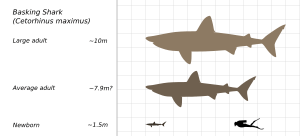Basking shark facts for kids
The Basking shark (Cetorhinus maximus) is a giant filter-feeding shark. It can grow up to 40 feet (12 meters) long, making it the second largest shark in the world, right after the Whale shark. People sometimes call it the Sunfish, the Bone shark, or the Big mouth shark.
Quick facts for kids Basking shark |
|
|---|---|
 |
|
 |
|
| The size of basking sharks at various stages of growth and maturity with a human for scale | |
| Conservation status | |
| Scientific classification | |
| Genus: |
Cetorhinus
|
| Species: |
maximus
|
 |
|
| Range of the basking shark | |
Contents
What Does a Basking Shark Look Like?
The Basking shark is easy to spot because of its huge size. It has very long gill slits that almost go all the way around its head. This helps tell it apart from other sharks. Its snout is shaped like a cone, and it has many large gill rakers inside its mouth. These rakers are like a sieve, used for filtering food.
The shark's enormous mouth opens very wide, going past its small eyes. Inside, it has hundreds of tiny, hooked teeth. The Basking shark also has a very large liver, which can be up to 25% of its body weight! This liver helps the shark float in the water so it doesn't sink.
Most Basking sharks are greyish-brown on top, but their color can range from dark grey to almost black. Their underside is usually lighter, often a pale white.
As the second largest shark, the Basking shark can reach lengths of up to 40 feet (12 meters). However, most adults are about 22–29 feet (6.6-8.7 meters) long. When they are born, they are already quite big, around 5–6 feet (1.5-1.8 meters) long. These sharks grow very slowly and might not be ready to have babies until they are 16–20 feet (4.8–6 meters) long.
Where Do Basking Sharks Live?
Basking sharks live in both coastal and open ocean waters around the world. They prefer cooler, temperate and arctic areas.
You can find them in:
- The western Atlantic Ocean, from Newfoundland to Florida, and from southern Brazil to Argentina.
- The eastern Atlantic, from Iceland and Norway to Senegal, including parts of the Mediterranean Sea.
- The western Pacific Ocean, off Japan, China, the Koreas, western and southern Australia, and New Zealand.
- The eastern Pacific, from the Gulf of Alaska to the Gulf of California, and from Ecuador to Chile.
How Basking Sharks Behave
Basking sharks are often seen alone, but they can also travel in pairs or large groups of 100 or more. Scientists don't fully understand why their behavior changes so much. They are known to travel long distances, especially in winter when they go to deeper waters to find food.
When you see them swimming in circles, it's thought they might be trying to get the attention of other sharks for mating. They can spend hours doing this!
How Basking Sharks Find Food
The Basking shark is one of only three types of giant filter-feeding sharks, along with the Whale shark and the Megamouth shark. The Basking shark is unique because it has to keep swimming to push water through its mouth and gills.
It swims with its huge mouth wide open, taking in a steady flow of water. Tiny food particles are caught by special gill rakers in its gill slits. A Basking shark's gill rakers can filter up to 2,000 tons of water every hour!
These sharks eat tiny sea creatures called zooplankton. This includes small crustaceans, baby invertebrates, and fish eggs and larvae. Scientists believe that Basking sharks feed near the surface when there's a lot of plankton. Some think they might even shed their gill rakers and rest in deeper water during winter. It's still a mystery how often they shed and regrow these important parts.
Basking Shark Life Cycle and Reproduction
Basking sharks are ovoviviparous. This means their young grow inside eggs within the mother's body, but they hatch inside her and are born live. The babies get their food from a yolk sac, not from a direct connection to the mother.
It's thought that female Basking sharks can be pregnant for a very long time, from 1 to 3 years! Mating usually happens in early summer. When it's time for the babies to be born, the females often move to shallow waters. A mother shark can have up to 6 pups, and each one can be up to 6 feet long at birth.
Basking sharks become old enough to mate when they are around 6 to 13 years old, and about 15 to 20 feet long. They can live for up to 50 years.
How Basking Sharks Migrate
Basking sharks travel a lot. Off the Atlantic coast of North America, they appear in the southern areas (like North Carolina to New York) in spring. Then they move north (to New England and Canada) in summer. They disappear in autumn and winter, likely moving to deeper, warmer waters.
Near the southwest coast of the United Kingdom, Basking sharks feed near the surface in summer. They are not seen from November to March, suggesting they migrate away from the coast during winter. This migration follows where the most zooplankton (their main food) can be found. When they migrate, Basking sharks often form groups based on their size and gender.
Basking Shark Parasites
Sometimes, people see Basking sharks leaping out of the water. No one is completely sure why they do this. Some scientists think they might be trying to shake off parasites or other creatures that attach to their skin, like remoras or sea lampreys. These creatures might irritate the shark enough to make it jump or rub against objects to get them off. Even the cookiecutter shark is known to take bites out of Basking sharks!
Protecting Basking Sharks
Basking sharks have been hunted in the past for their large livers. Their liver oil was used in Japan and by fishermen in the United Kingdom for lamps and cosmetics.
Because these sharks grow slowly and don't have many babies, they are very sensitive to over-fishing. If too many are caught, their populations take a very long time to recover. Today, a big threat comes from the demand for their fins for shark fin soup. They also get caught by accident in fishing nets. It's hard to know exactly, but some reports suggest that the number of Basking sharks has dropped by 80% since 1950. This is why it's so important to protect them!
Images for kids
-
Basking shark filter feeding at Dursey Sound
See also
 In Spanish: Tiburón peregrino para niños
In Spanish: Tiburón peregrino para niños







